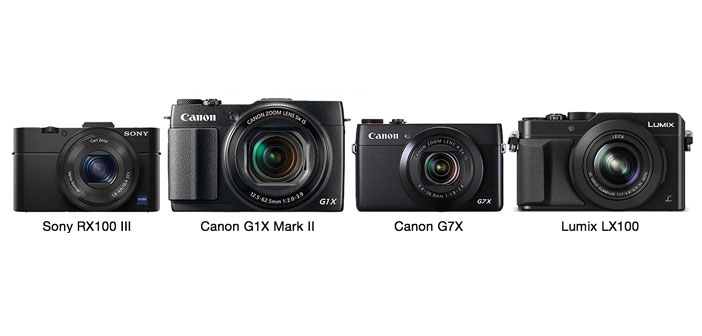The Photokina 2014 is still in progress, but all of the most important changes have already been presented in recent days. The sector of the premium compact with large sensor is the one that in recent years has been churning out the most interesting products, with ever more efficient models and feature-rich, in slender bodies and transportable.
As we have already pointed out on more than one occasion, have lost the traditional compact and attractive market because of smartphones, so it was necessary to evolve to offer something more.
Obviously, prices have soared, but the quality is now comparable to that of an SLR with lenses and often more interesting. Some cameras in this category have adopted APS-C sensors, see Fujifilm X100 or Nikon Coolpix A, but to limit the space it was necessary to settle for fixed lenses (35mm and 28mm).
We will focus on the more practical models with zoom lenses, focusing on those with sensors equal to or greater than 1″. In this area, we have identified four cameras of reference, the two already on the market and two just presented that will be available from November. Below you will find a list of technical specifications for comparison, where marked in green are the characteristics that we consider the best in each model.
If we count only the areas in which each camera excels the Panasonic Lumic LX100 win with 8 green areas, but this is not necessarily the method to identify the best model for our needs. We prefer the more compact, choosing the Sony RX100 M III (whose review is in progress) or the one with the lens more comfortable (I believe the Canon G7X for hiking / brightness) or even the cheapest one, where for the moment, prevails Canon G1X Mark II.
| Feature / Model | Sony RX100 M III | Canon G1X II | Canon G7X | Panasonic LX100 |
|---|---|---|---|---|
| Sensor | 1″ (13.2 x 8.8 mm) | 1.5″ (18.7 x 14 mm) | 1″ (13.2 x 8.8 mm) | 4/3 (17.3 x 13 mm) |
| Resolution | 21MP | 13MP | 20MP | 13MP |
| ISO | 125-12,800 | 100-12,800 | 125-12,800 | 200-25,600 |
| Target | 24-70mm f/1.8-2.8 | 24-120mm f/2-3.9 | 24-100mm f/1.8-2.8 | 24-75mm f/1.7-2.8 |
| Stabilization | Optics | Optics | Optics (5 axis) | Optics |
| Macro | 5cm | 5cm | 5cm | 3cm |
| AF points | 25 | 31 | 31 | 49 |
| Screen | 3 “(1,228,800) Tilt |
3 “(1,040,000) Tilt |
3 “(1,040,000) Tilt |
3 “(921,000) Fisso |
| Touchscreen | No | Yes | Yes | No |
| Viewfinder | 0.59x (1,440,000) | No (optional) | No | 0.70x (2,764,000) |
| Max Shutter | 1/2000 | 1/4000 | 1/2000 | 1/16000 |
| Filtro ND | Si (3 stop) | Si (3 stop) | Si (3 stop) | No |
| Gust | 10fps | 5.2fps | 6.5fps | 11fps |
| Flash | Internal (5.7m) | Internal (6.8m) | Internal (7m) | Separate (7m) |
| Sled Flash | No | Yes | No | Yes |
| Video | FullHD 50fps MPEG-4/AVCHD/XAVC S |
FullHD 25fps MPEG-4/H.264 |
FullHD 50fps MPEG-4/H.264 |
4K 25fps, FullHD 50fps MPEG-4/AVCHD |
| Audio | Stereo | Stereo | Stereo | Stereo |
| Microphone | No | No | No | No |
| Wireless | Wi-Fi / NFC | Wi-FI / NFC | Wi-Fi / NFC | Wi-Fi / NFC |
| Autonomy | 320 shots | 240 shots | 210 shots | 300 shots |
| Dimensions | 102 x 58 x 41 mm | 116 x 74 x 66 mm | 103 x 60 x 40 mm | 115 x 66 x 55 mm |
| Weight | 290 grams | 553 grams | 304 grams | 393 grams |
| Collars Parameters | 2 | 2 + Fire | 2 | 2 |
| Price | $798 | $749 | $699 | $899 |
So the choice is not necessarily so obvious, but the list of specifications should allow each of you to select your favorite camera based on its strengths. Assuming to be a lover of the Pansonic Lumic LX100 viewfinder offers the largest and most resolute, but it is also one of the most voluminous of the group, as well as the most expensive.
Then you could opt for the Sony RX100 M III, where it is present while being smaller, and something they would save on the purchase price, but you would lose the video in 4K, and the sensor would be smaller. In short, each of us can make his arguments on the basis of these specifications, so we hope that the comparison could be useful in the evaluation. We are curious to know what is your favorite and why.

